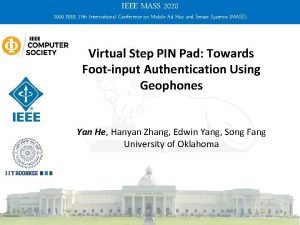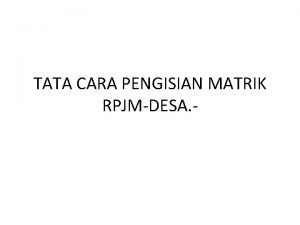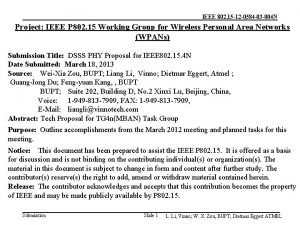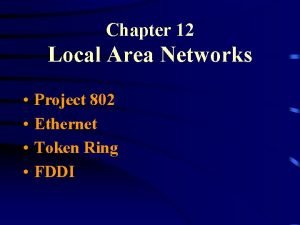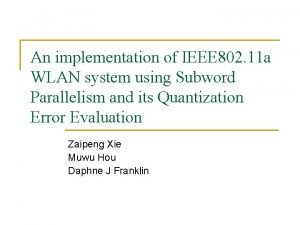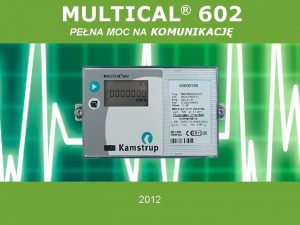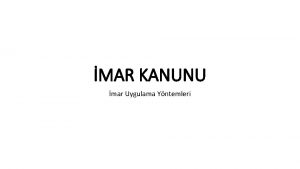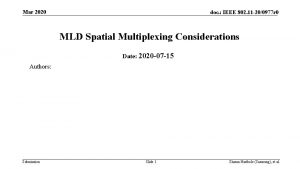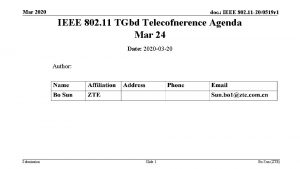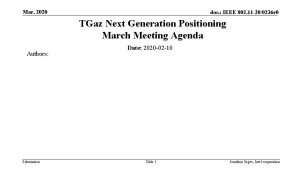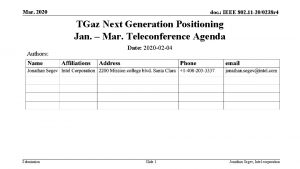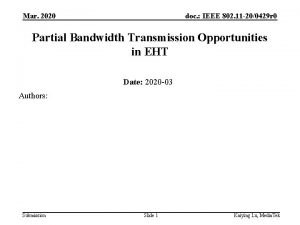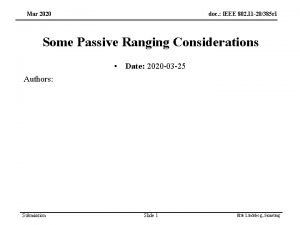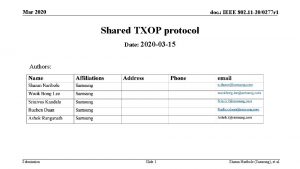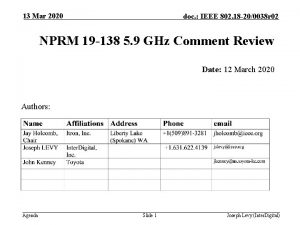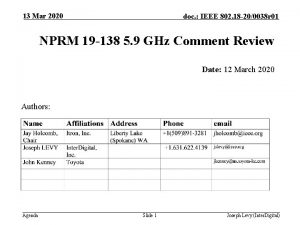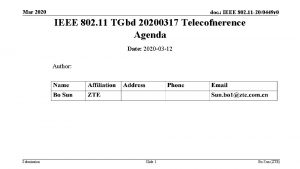Mar 2020 doc IEEE 802 11 200470 r
















![Mar 2020 doc. : IEEE 802. 11 -20/0470 r 1 Reference • [1] Jianhan Mar 2020 doc. : IEEE 802. 11 -20/0470 r 1 Reference • [1] Jianhan](https://slidetodoc.com/presentation_image_h2/9b4769785f04b4632856a042e05ca420/image-17.jpg)



- Slides: 20

Mar 2020 doc. : IEEE 802. 11 -20/0470 r 1 Small Size MRU with Different MCS and BCC Date: 2020 -03 -16 Authors: Name Affiliation Address Phone Email Junghoon Suh junghoon. suh@huawei. com Yan Xin yan. xin@huawei. com Osama Aboul-Magd Huawei osama. aboulmagd@huawei. com Ross Jian Yu ross. yujian@huawei. com Edward Au edward. ks. au@huawei. com Submission Slide 1 Junghoon Suh, et. al, Huawei

Mar 2020 doc. : IEEE 802. 11 -20/0470 r 1 Background • 802. 11 be shall allow more than one RUs to be assigned to a single STA [1] • • Small-size RUs can only be combined with small-size RUs and the large-size RUs can only be combined with the large-size RUs [2] Small-size RUs shall not cross 20 MHz channel boundary and the only allowed small-size RU combinations are RU 106+RU 26 and RU 52+RU 26 [2] For LDPC encoding, each PSDU only uses one encoder [3], but there is no decision on BCC yet For LDPC coding, for combined RUs sent to a user with RU size less than 242 -tone, a single tone mapper shall be used [5] • We want to evaluate the impact of the freq. selective channels when the multiple RUs are far apart with each other • Especially, for small RU cases, we evaluated how to implement the BCC encoder, Interleaver and QAM mapper Submission Slide 2 Junghoon Suh, et. al, Huawei

Mar 2020 doc. : IEEE 802. 11 -20/0470 r 1 Channel Impact on Far-apart RUs (1) • Two MRU cases under test with IEEE Chan. D without any interferences 80 MHz 26 -RU 1 2 3 4 5 6 7 9 8 242 -RU 52 -RU • 1 2 3 4 4 We observed the RX average signal energy per tone for each RU with the sum of signal energy per tone divided by the number of tones per each RU – For 20 MHz, 52 -RU 1 is about 1. 74 d. B higher than 26 -RU 9 – For 80 MHz, 242 -RU 1 is about 9. 67 d. B higher than 242 -RU 4 • The RX average signal energy per tone for each RU above purely indicates the channel gain difference between two RUs Submission Slide 3 Junghoon Suh, et. al, Huawei

Mar 2020 doc. : IEEE 802. 11 -20/0470 r 1 Channel Impact on Far-apart RUs (2) • • • One symbol of Long Training Sequence (LTS) is used For 20 MHz, the LTS is oversampled by 5 times in time domain to align with the 10 nsec PDP Tap Spacing [4] before passing through the channel For 80 MHz channel, first we generate the channel D parameters and run 4 x interpolation to make the channel parameters 2. 5 nsec PDP Tap spacing, and then, the LTS is oversampled by 5 times in time domain to align with the 400 MHz sampling rate of the channel parameters [4] before passing through the channel 1. 74 d. B Submission Slide 4 Junghoon Suh, et. al, Huawei

Mar 2020 doc. : IEEE 802. 11 -20/0470 r 1 Evaluation Option 1 for 20 MHz PPDU, MRU with Different MCS vs. the Same MCS MAC • • • PSDU Constellation Mapper RU-A Interleaver Constellation Mapper RU-B Interference Parser RU-A (26 -RU 9) is scheduled with MCS 5, and RU-B (52 -RU 1) is scheduled with MCS 7 for the different MCS case RU-A (26 -RU 9) is scheduled with MCS 7, and RU-B (52 -RU 1) is scheduled with MCS 7 for the same MCS case BCC Encoder needs to change the puncturing pattern in the middle of each OFDM symbol according to the MCS changes – • BCC Encoder Interleaver Significant change necessary in the current encoder implementation Current 802. 11 Interleaver can still be used – The separate interleaver should be used even for the same MCS case • – Performance drop takes place in case the same MCS is applied to RU-A and RU-B New interleaver design is necessary if we want to apply the common interleaver for both RU-A and RU-B Submission Slide 5 Junghoon Suh, et. al, Huawei

Mar 2020 doc. : IEEE 802. 11 -20/0470 r 1 MCS Modulation Code Rate 0 BPSK ½ 1 QPSK ½ 2 QPSK ¾ 3 16 -QAM ½ 4 16 -QAM ¾ 5 64 -QAM 2/3 6 64 -QAM ¾ 7 64 -QAM 5/6 8 256 -QAM ¾ 9 256 -QAM 5/6 Submission • We can choose the MCSs with the same code rate but different modulation to avoid the possible changes in the BCC encoder implementation – – • • • e. g. MCS 6 – 4, MCS 4 – 2, etc The goodput gain with the different MCS disappears due to the limited MCS selections Goodput is defined as the number of correctly decoded information bits per packet divided by the total air time per packet The SINR is measured at the RX across the entire 20 MHz band (but TX power is not boosted for small RU transmission in the simulation) As seen from the next slides, we can observe the gain when we apply the different MCSs to multiple RUs based on the channel quality in a full flexible manner, that is, we should be able to apply any set of MCSs to multiple RUs Slide 6 Junghoon Suh, et. al, Huawei

Mar 2020 doc. : IEEE 802. 11 -20/0470 r 1 -13 d. B Interference is added only to RU-A (26 -RU 9) with various MCS combinations Submission Slide 7 Junghoon Suh, et. al, Huawei

Mar 2020 doc. : IEEE 802. 11 -20/0470 r 1 -10. 5 d. B Interference is added only to RU-A (26 -RU 9) Submission Slide 8 Junghoon Suh, et. al, Huawei

Mar 2020 doc. : IEEE 802. 11 -20/0470 r 1 -7. 5 d. B Interference is added only to RU-A (26 -RU 9) Submission Slide 9 Junghoon Suh, et. al, Huawei

Mar 2020 doc. : IEEE 802. 11 -20/0470 r 1 -4. 5 d. B Interference is added only to RU-A (26 -RU 9) Submission Slide 10 Junghoon Suh, et. al, Huawei

Mar 2020 doc. : IEEE 802. 11 -20/0470 r 1 Observation so far • If we keep the common BCC encoder for both RUs, a significant performance drop is inevitable in case of the same MCS applied to both RUs • If we keep the common BCC encoder for both RUs, a significant change in the implementation of BCC encoder is necessary in case of the different MCS applied to each RU • It is not an option to apply only the MCS set with the same code rate but with the different modulation, due to the Goodput degradation • Hence, we propose the following Option 2 as an alternative to Option 1 to attain the gain but to minimize the implementation impact Submission Slide 11 Junghoon Suh, et. al, Huawei

Mar 2020 doc. : IEEE 802. 11 -20/0470 r 1 Option 2 • Apply the different BCC encoder and Interleaver to each RU when the multiple RUs are scheduled, so that the flexible MCS can be applied to each RU MAC • PSDU BCC Encoder Interleaver Constellation Mapper RU-A BCC Encoder Interleaver Constellation Mapper RU-B Encoder Parser Performance of Option 2 is similar to Option 1, while only the separate encoder is used for each RU to avoid the significant change in the implementation of BCC encoder Submission Slide 12 Junghoon Suh, et. al, Huawei

Mar 2020 doc. : IEEE 802. 11 -20/0470 r 1 Evaluation Option 3 for 20 MHz PPDU with a common Interleaver as well as a common BCC encoder • • In case we decide to apply the same MCS for MRU, a common interleaver for MRU may help reduce the performance degradation due to the different interference level and channel gain Apply the common BCC encoder and Interleaver to both RUs in order to achieve the freq. diversity gain – – New Interleaver design (Detail TBD) is necessary The same MCS between two RUs is applied RU-A MAC PSDU BCC Encoder Interleaver Constellation Mapper Parser RU-B Submission Slide 13 Junghoon Suh, et. al, Huawei

Mar 2020 doc. : IEEE 802. 11 -20/0470 r 1 -13 d. B Interference is added only to RU-A (26 -RU 9) for Option 3 We can observe the common interleaver shows a little frequency diversity gain when a common interleaver is applied to the small size MRU Submission Slide 14 Junghoon Suh, et. al, Huawei

Mar 2020 doc. : IEEE 802. 11 -20/0470 r 1 -13 d. B Interference is added only to RU-A (26 -RU 9), and RU-B is 106 -RU 1 for Option 3 Submission Slide 15 Junghoon Suh, et. al, Huawei

Mar 2020 doc. : IEEE 802. 11 -20/0470 r 1 Summary Option 1 Pros Cons • Aligned with LDPC TX flow (excluding interleaver) Throughput enhancement with the flexible MCS applied to MRU • Change in the BCC encoder architecture Throughput enhancement with the flexible MCS applied to MRU • • Option 2 • Not aligned with LDPC TX flow • Keep using the same 802. 11 BCC encoder and Interleaver Option 3 Submission • Aligned with LDPC TX flow • Keep using the same 802. 11 BCC encoder Slide 16 • New interleaver design is necessary • Freq. diversity gain is little for small size RU Junghoon Suh, et. al, Huawei
![Mar 2020 doc IEEE 802 11 200470 r 1 Reference 1 Jianhan Mar 2020 doc. : IEEE 802. 11 -20/0470 r 1 Reference • [1] Jianhan](https://slidetodoc.com/presentation_image_h2/9b4769785f04b4632856a042e05ca420/image-17.jpg)
Mar 2020 doc. : IEEE 802. 11 -20/0470 r 1 Reference • [1] Jianhan Liu (Media. Tek), “Enhanced resource allocation schemes for 11 be, ” 19/1126 r 1, September 2019 • [2] Jianhan Liu (Media. Tek), “Multiple RU combinations for EHT, ” 19/1907 r 2, January 2020 • [3] Bin Tian (Qualcomm), “Preamble puncturing and RU aggregation, ” 19/1869 r 2, January 2020 • [4] Jianhan Liu (Media. Tek), “TGbe channel model document, ” 19/719 r 1, July 2019 • [5] Ross Yu (Huawei), “Multiple RU discussion, ” 19/1914 r 4, January 2020. Submission Slide 17 Junghoon Suh, et. al, Huawei

Apr 2020 doc. : IEEE 802. 11 -20/0470 r 1 SP 1 • Do you agree that, for a single RU less than or equal to 242 tones, the BCC can be supported? – Mandatory or Optional for BCC, TBD Submission Slide 18 Junghoon Suh, et. al, Huawei

Apr 2020 doc. : IEEE 802. 11 -20/0470 r 1 SP 2 • Do you agree that, for the combined multiple RU with the combined RU size less than 242 tones, the BCC can be supported? – Mandatory or Optional for BCC, TBD Submission Slide 19 Junghoon Suh, et. al, Huawei

Apr 2020 doc. : IEEE 802. 11 -20/0470 r 1 SP 3 In case of small size MRU transmission, which option do you support? • Option 1: common BCC encoder but separate Interleaver • Option 2: separate BCC encoder and Interleaver for the multiple RUs • Option 3: common BCC encoder and Interleaver for the multiple RUs Submission Slide 20 Junghoon Suh, et. al, Huawei
 Bridges from 802.x to 802.y
Bridges from 802.x to 802.y Bridges from 802.x to 802.y
Bridges from 802.x to 802.y Estandares 802
Estandares 802 802 ieee
802 ieee Ieee 802 family
Ieee 802 family Wlan standards
Wlan standards Ieee 802 standard
Ieee 802 standard Ieee 802
Ieee 802 Ieee 802 3 compliance
Ieee 802 3 compliance Arquitetura ieee 802
Arquitetura ieee 802 Bluetooth ieee 802
Bluetooth ieee 802 Ieee mass 2020
Ieee mass 2020 Format rps dikti 2020 doc
Format rps dikti 2020 doc Format matrik rpjm desa
Format matrik rpjm desa Rejestr wypadków przy pracy 2020 doc
Rejestr wypadków przy pracy 2020 doc Mac address
Mac address 802 15
802 15 Project 802
Project 802 Wlan 802
Wlan 802 Geo 802
Geo 802 Filler 602
Filler 602











